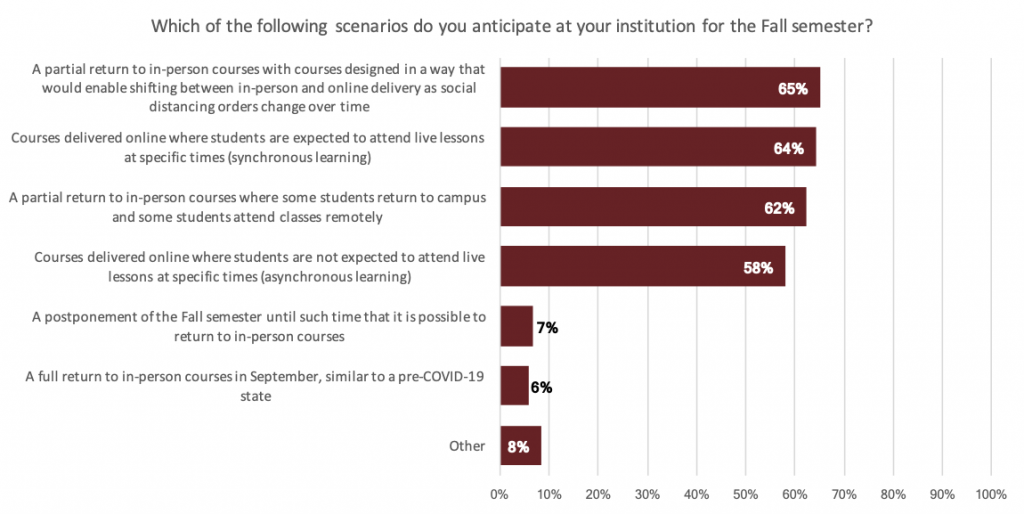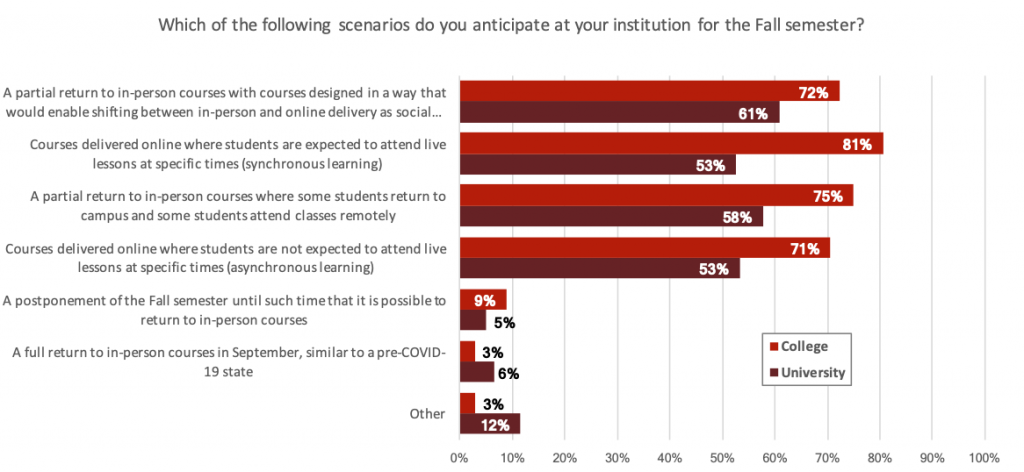The Canadian Pulse Project is a multi-stage effort to track the impact of the COVID-19 pandemic on higher education institutions across Canada. This post is the first in a series that shares the results from our first survey.
Canadian Higher Education in Fall 2020: Multiple Online and Hybrid Learning Scenarios
Despite the uncertainty facing most institutions, there is little expectation that the fall term will return to a pre-COVID-19 model of instruction. Likewise, programs are expected to be modified, not canceled.
Canadian institutions are beginning to announce their plans for the fall semester of 2020, as they consider how to proceed amidst the ongoing COVID-19 pandemic. Early insights about what higher education might look like for the foreseeable future indicate that programs will continue online in September and it will not be business as usual. What are the different scenarios that could exist in a predominantly online learning model of higher ed?
From April 24 through May 1, 2020, the Canadian Digital Learning Research Association (CDLRA) research team surveyed 273 faculty and administrators from across Canada to explore the learning scenarios they anticipated for fall. The survey was a collaborative effort between Nicole Johnson (Canadian Digital Learning Research Association), George Veletsianos (Royal Roads University), Jeff Seaman (Bay View Analytics), and Academica Group.
Respondents indicated that a full return to in-person classes was not a possibility, which is consistent with early announcements from institutions. At the same time, few respondents anticipated that classes would be canceled or postponed. In other words, most respondents were in agreement that the school year will go ahead, but the experience will be very different.
Faculty and administrators are envisioning multiple scenarios. Most respondents indicated that several possibilities were likely, from fully online options with no in-person classes to hybrid options that may involve a) some students returning to campus while others continue learning online or b) shifting students between in-person and online courses depending on what the local pandemic response warrants.
The chart below lists the different options for the fall semester and the proportion of faculty and administrators that selected that it would be likely.

We also observed differences between universities and colleges. Respondents from colleges most often indicated that fully online courses delivered synchronously was most likely, followed by a hybrid option in which some students attend classes on campus while others attend classes online.
Respondents from universities were most likely to report: a) a partial return to in-person courses that would enable shifting between in-person and online classes as social distancing orders change over time and/or b) a partial return to in-person classes where some students return to classes and other students attend classes online.

Ultimately, higher education in Canada in Fall 2020 will be different and there will be variations in how online and hybrid approaches are implemented from institution to institution. It is also important to note that multiple approaches may be implemented depending on the nature of the program and changes in orders by provincial health officers.
With regard to next steps, now that we know much of higher education will begin online in the fall semester, Nicole Johnson (Research Director, CDLRA) noted, “Considering what faculty and administrators anticipate and the early announcements being made by institutions, it is evident that online and hybrid learning will be the new normal for the upcoming academic year. For institutional leaders and governing bodies, the summer months will be a critical time for determining the different online/hybrid scenarios for their institution, training faculty accordingly, and taking measures for setting students up for success in an online environment.”
“Canadian post-secondary institutions agree that they will be open in the fall, that it won’t be like it was, and that there is not a single scenario that will be the best match for the evolving situation,” said Jeff Seaman (Director, Bay View Analytics). “Their understanding of the multiple alternatives for the fall semester shows that they consider flexibility to be key.”
George Veletsianos (Professor & Canada Research Chair, Royal Roads University) commented, “Higher Education in Canada in Fall 2020 will look much different than last Fall. While this is partially about continuity, it also needs to be about re-imagining a wide range of practices, ranging from delivery models, to assessment practices, to student support, just to mention a few.”
“As Canadian higher-ed prepares for a fall subjected to uncertainty yet demanding clarity, it will be fascinating to observe how institutional plans develop and take shape,” said Bruce Thompson, Senior VP, Academica Group.
Background to the Research
The survey was open for one week from April 24 through May 1, 2020. Invitations to participate were included in the Academica Top Ten on April 24th, April 28th, and May 1st. Of the total of 14 questions, ten were displayed to faculty respondents and 13 to administrators. Since many academics have both teaching and administrative responsibilities, respondents were asked to select their primary role and were only presented with questions for that role. Where appropriate, questions included an ‘other’ response where the respondent could provide their own detailed answer.
Respondents included 273 higher education faculty and administrators from across Canada with most of the responses coming from Ontario, Alberta, and British Columbia. All data were checked for completeness, missing values, or erroneous codes. All responses entered as ‘other’ were reviewed to determine if they should also be coded as one of the fixed responses. The only required question for the survey was that of the role of the respondent (faculty or administrator), so respondents could skip any question or portion of a question. Very few respondents skipped questions, but all surveys where less than three-quarters of the eligible questions were completed were deleted from the analysis. The survey was available in both English and French, but it should be noted that the majority of surveys were completed in English.
For information on the status of online learning in Canadian post-secondary institutions prior to COVID-19, download the CDLRA’s 2019 National Report and our 2019 National Infographic:

